Tile that Dungeon! – Part One
By G. Bruce MacKenzie
Righto! Time to holster the space blasters for a bit and return to the main d’oeuvre. This is the first in what will be a short series of articles about “Dungeon Tiles”. That’s right, those delightful accessories for use with, what were standard in the 1980s, 15 millimeter or 25 millimeter miniatures. Although one must admit the idea is not exclusive to dungeon adventures the initial articles will be about some old dungeon products I happen to have on hand myself before we roll up our sleeves for a little Bree-Yark d-i-y know how.
Back in the good ol’ days I was fortunate enough to have a boxed set of the Fantasy Paths illustrated by Dennis McGlumphy. Many of us will remember these as being bundled with the Chaosium rules for Basic Role Playing. That did get me interested in RuneQuest at the time, enough to purchase those rules and study them but of course I had bought the set to use with D&D.
Recently I was able to re-acquire a complete boxed set of the McGlumphy illustrated tiles, albeit in the form of a slightly different boxed set from BCS (Board Craft Simulations) and Platypus of Pleasant Hill California. Yes, that is what the box says, Platypus. The set is Card Castles #80, and is billed as a Game Board for Generation of Dungeons, Castles, Empires. Now if you are a fan of these tiles as I am your thinking, “Ooh! Bring on the previous 79 sets!” Sadly for us I suspect the designated #80 is merely a product number but I do know that Castle Paths and Village Paths were also produced.
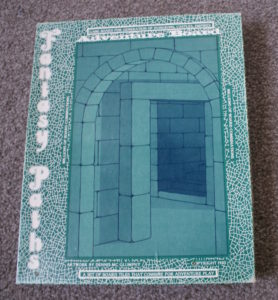
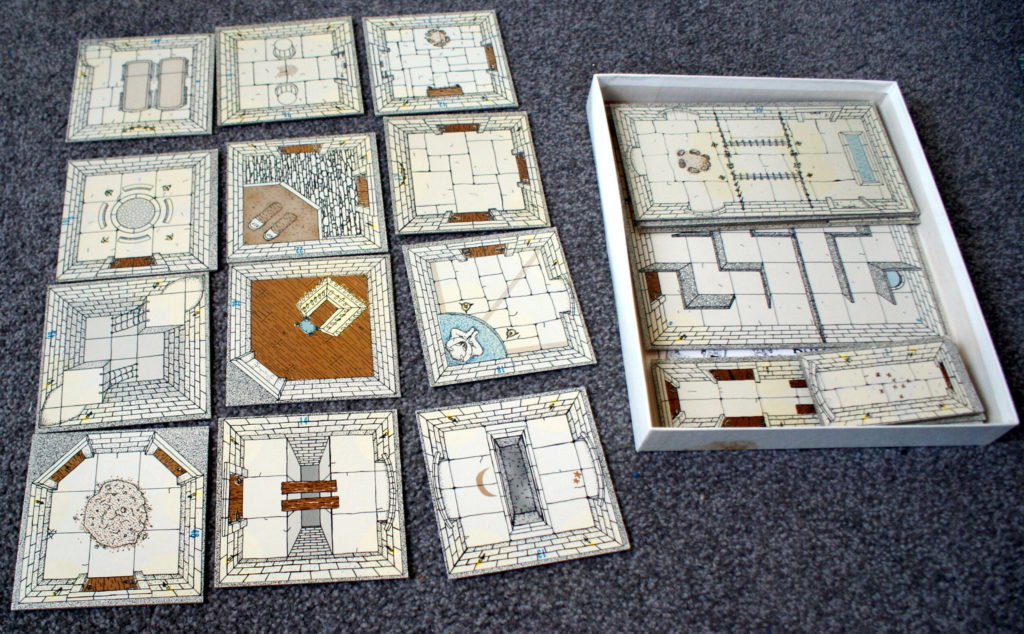
Well, lets waste no time and get on to the substance of the article. The green boxed set of Fantasy Paths, from 1980, contains dungeon tiles which are printed double sided on thick cardboard. They come in a variety of sizes and the set comes with rules as to how the user can compose dungeons using a notation system, for example: each tile comes with a printed number indicating top, so the user records the dungeon layout in a grid form writing the number of the tile and the cardinal direction which the number faces:
|
– (blank) |
44S |
43W |
|
41N |
48S |
49N |
The layout for the above nifty notation then appears as follows:
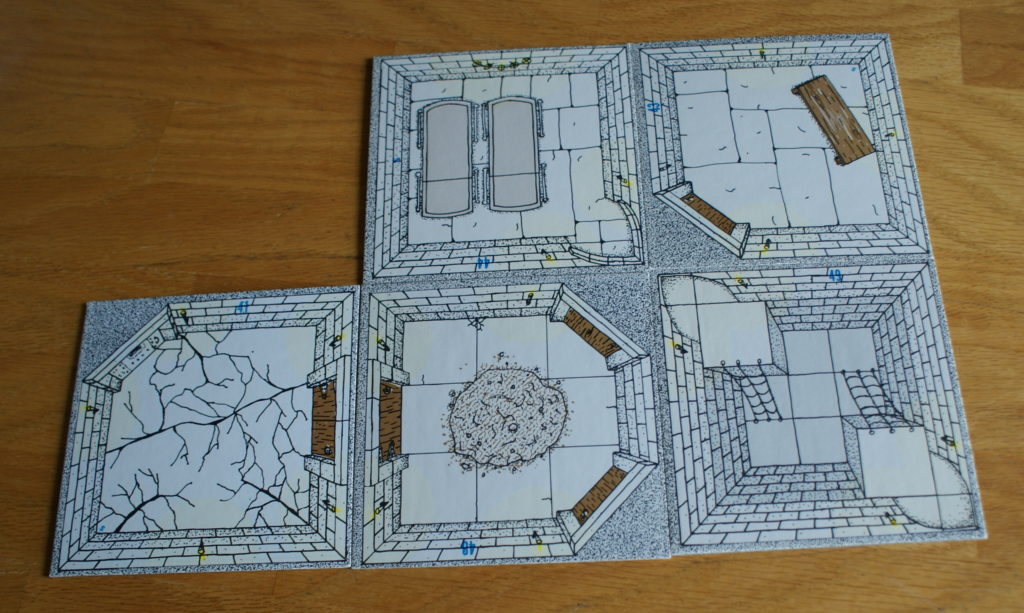
As one can appreciate this saves a great deal of drawing time but the principal limitation is that the tiles do not easily interpret the kind of hand drawn maps one may have been previously accustomed to. In high school for example we busied ourselves with graph paper sketching dungeon rooms but those sort of maps do not quite lend themselves to the tile set. Therefore, in order to use the Fantasy Paths successfully consider working within the tiles provided in the set and/or add tiles in the same milieu.
The tile illustrations by Dennis McGlumphy are charming and atmospheric. Players can see exactly the sort of physical space they are in. The tiles are complete with flagstone floors, lit and unlit torches, pools of illumination, and wonderful doors. Potential secret passages are indicated by a “$” printed on the tiles, and of course many contain objects of various kinds. The tiles are wonderful in a quirky whimsical way. Because the floors are not systematically represented in 1” squares it means that applying movement rules falls somewhat within the realm of the imagination however the spaces represented within the tiles are small, so this is not really critical except when moving across groups of tiles. Time to get out a ruler, or string marked in inches.
Of course the limited number of tiles in the set means that one soon wishes there were many more tiles. Repetition and re-use means one soon has to tell players if something represented on a tile is actually present or not. Secret passages, their potential, is indicated on the tiles for all to see so that is something of a dead give-away if used by rote. Time to get out the pencils! The truly creative soon make additional tiles of their own.
One dungeon of mine for first edition AD&D has managed to survive due to archiving, it is easily translated into Basic D&D since the first edition Monster Manual is Basic D&D compatible. The map I made illustrates the use I made of the tiles back in the day although it appears I did not use the notation system. It was fun to lay out the tiles once more and reflect on the fun we had. I would have transcribed this dungeon but I think the hand written notes convey the times in which they were written, so check out the PDF.
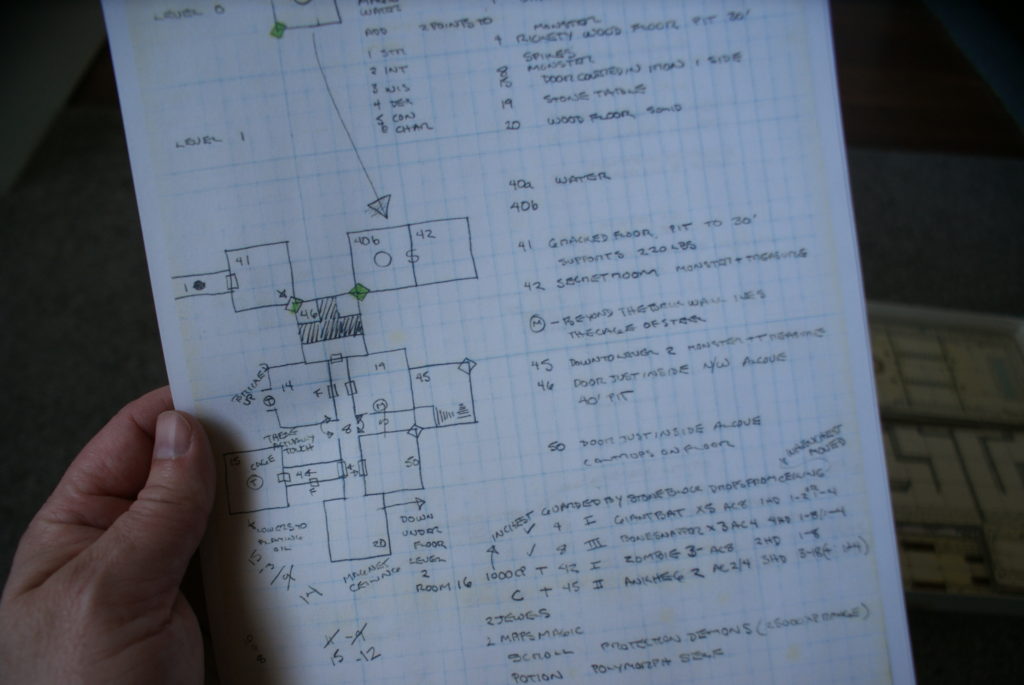
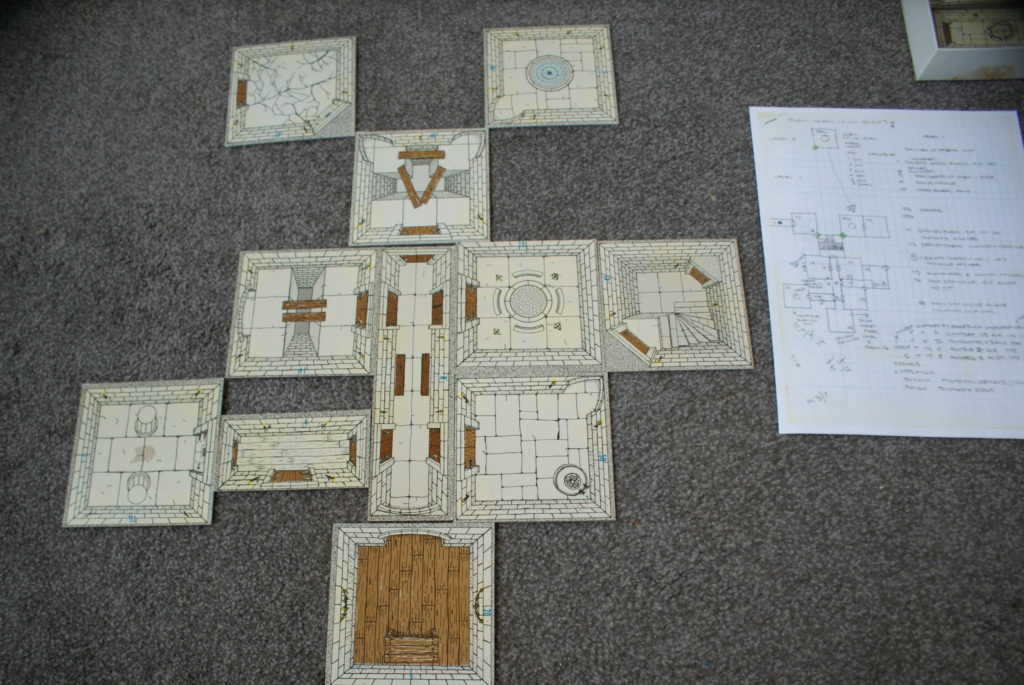
When using the tiles keep in mind that you can only use one side of a tile at a time. I made the mistake of using both sides of one tile on the same map! The following is a list of the numbers on the tiles from the set I have now. I have no idea if this represents the entire list of tiles that should be in the box but it looks reasonably complete. There is some interesting sequential numbering after tile 50, but as it turns out there are 56 different floor plans in total.
|
Tile Front |
Reverse Side |
|---|---|
|
1 |
29 |
|
2 |
30 |
|
3 |
31 |
|
4 |
32 |
|
5 |
33 |
|
6 |
34 |
|
7 |
35 |
|
8 |
36 |
|
9 |
37 |
|
10 |
38 |
|
11 |
39 |
|
12 |
40 |
|
13 |
41 |
|
14 |
42 |
|
15 |
43 |
|
16 |
44 |
|
17 |
45 |
|
18 |
46 |
|
19 |
47 |
|
20 |
48 |
|
21 |
49 |
|
22 |
50 |
|
23 |
53 |
|
24 |
52 |
|
25 |
54 |
|
26 |
51 |
|
27 |
56 |
|
28 |
55 |
In closing we shall say no more lest we give away all our arcane secrets at once but that there will soon be an article to follow this one!
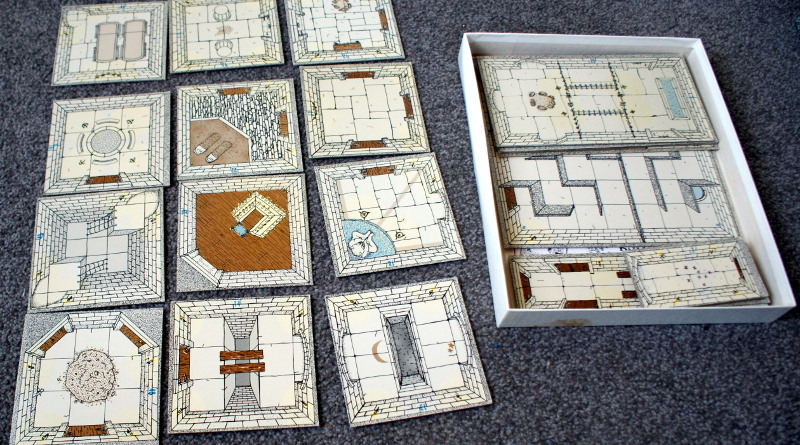
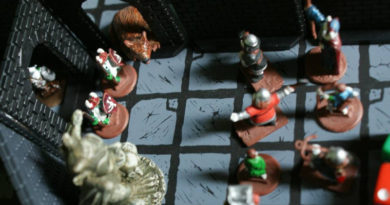
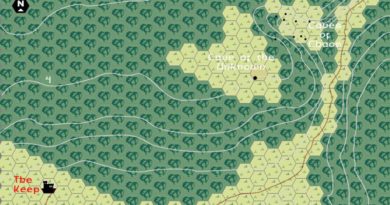

Hi, Greg, I just came across your article for the original Fantasy Paths and thought I would give some history on this product since it is very incomplete. First, I remember the original idea came from a man named Victor (can’t remember his last name) and his son. But, I will use Dennis to ID him here.
Back in 1980, Dennis’s son was a regular at my game story that featured a gaming area in the back. Fantasy role playing games were at the top of the list for adults, teens and kids to be playing back then. Dennis’s son around 11 or 12 years old at the time. He was an avid player, and came up with the idea after getting tired of drawing maps on paper or having no map area at all.
Dennis and his son came to me with the idea for Fantasy Paths and his rough sketches. We loved it and agreed to make and publish the tiles. Dennis created Platypus Press as the creative art and publishing end of the project. I created Board-Craft Simulations (BCS) for the marketing and distribution. We all collaborated on the tiles and Dennis did the original drawings and cover artwork (green box).
The initial offering did not sell off very well. Dennis decided he no longer wanted to put in the time and money to continue the project. I thought it could still be a success, so BCS bought the rights for Fantasy Paths and started to work on a reboot of the product.
Our major effort was to convert the product from just a box of tiles into a stand-alone game. To do this we made several changes. First was new box art for the front and back, as well character/monster counters for gamers to use. Second was inserting the Chaosium Basic Role Playing (BRP) rules into the game. I was friends with Greg Stafford. When I brought the idea to him of using his BRP in the game, Greg was gracious enough to allow BCS to insert his BRP rules into the boxset. The last upgrade was writing an adventure scenario for use with the gaming tiles and counters.
We took these changes and re-released the product in 1981. In addition, we also expanded the tiles into two other sets: Castle Paths and Village Paths. Both also included the Chaosium BRP as well as separate adventure scenarios for use with the games. One highlight of the project was having Greg and the guys from Chaosium, at Gencon, sit down and play test the Village Path adventure.
The tiles were well received, and TSR showed interest in buying them when they were released. In one review we were described as the “Cadillac of game accessories…” and our price tag was considered too high for the average buyers ($15.95 in 1982). Printing was much more expensive back then with no computer graphics or inexpensive color printing. Each color had to be done in separate overlays that cost money. More color, more money.
So, between our price tag and cost, plus cheaper tiles starting to come out by bigger houses, the Fantasy Path line did only moderately well. In the end, we also decided not to put any further time or money into the project. It was short lived, but it was a hoot to create and we all had a load of fun doing it.
Notes for the BCS Reboot credits: Owners of BCS were Charles Schwartz (me) and Skip Dugger. Artwork for the boxes, character/monster counters and tile details were Lisa A. Free. Drawing and design for the Castle and Village Paths was by Charles Schwartz. All three adventures were written by Charles Schwartz with input from Brian Babcock and Dick Wagenet. Marketing was Gigi Traxler, while Steve Olsen assisted with distribution. Additionally, we had support from many other gamers who helped playtest the product at the store, Games Unlimited, in Pleasant Hill, CA back in 1981-1982.
Thank you so much Charles for sharing this. 😀 The price did not put me off back in the day and I bought my first set at our local store because the tiles were so cool. I still like them a lot. I’d like to express my thanks to you and all the folks involved in bringing the idea to life because we sure had a lot of fun with the tiles!
Hi, Greg,
How kind of you to respond. As the joke goes…”so you were the one that bought that set!” Glad you enjoyed the Paths. We had a lot of fun developing and playing the games. Also, a bit of trivia; the two people on the box covers are me and Lisa. She decided to use us as the cover art and surprised me with it. Lol. Schlopo and Malignik were our characters in Runequest, as was my character Webilton D. Down.
Thanks, Greg
Hi Charles, I’m glad to hear from you again. That’s pretty cool you ended up on the cover 😉 This is the kind of trivia that is fun to know and others will enjoy it as well. Those sets were very influential. They encapsulate a period of game play which I fondly remember to this day. 🙂 I purchased my set in Halifax Nova Scotia, so the boxes traveled quite far from their point of origin. I dabbled in RQ but we really used the tiles with 1E D&D.
Hi, Greg,
How kind of you to respond. As the joke goes…”so you were the one that bought that set!” Glad you enjoyed the Paths. We had a lot of fun developing and playing the games. Also, a bit of trivia; the two people on the box covers are me and Lisa. She decided to use us as the cover art and surprised me with it. Lol. Schlopo and Malignik were our characters in Runequest, as was my character Webilton D. Down.
Thanks, Greg
Hi, Greg, I just came across your article for the original Fantasy Paths and thought I would give some history on this product since it is very incomplete. First, I remember the original idea came from a man named Victor (can’t remember his last name) and his son. But, I will use Dennis to ID him here.
Back in 1980, Dennis’s son was a regular at my game story that featured a gaming area in the back. Fantasy role playing games were at the top of the list for adults, teens and kids to be playing back then. Dennis’s son around 11 or 12 years old at the time. He was an avid player, and came up with the idea after getting tired of drawing maps on paper or having no map area at all.
Dennis and his son came to me with the idea for Fantasy Paths and his rough sketches. We loved it and agreed to make and publish the tiles. Dennis created Platypus Press as the creative art and publishing end of the project. I created Board-Craft Simulations (BCS) for the marketing and distribution. We all collaborated on the tiles and Dennis did the original drawings and cover artwork (green box).
The initial offering did not sell off very well. Dennis decided he no longer wanted to put in the time and money to continue the project. I thought it could still be a success, so BCS bought the rights for Fantasy Paths and started to work on a reboot of the product.
Our major effort was to convert the product from just a box of tiles into a stand-alone game. To do this we made several changes. First was new box art for the front and back, as well character/monster counters for gamers to use. Second was inserting the Chaosium Basic Role Playing (BRP) rules into the game. I was friends with Greg Stafford. When I brought the idea to him of using his BRP in the game, Greg was gracious enough to allow BCS to insert his BRP rules into the boxset. The last upgrade was writing an adventure scenario for use with the gaming tiles and counters.
We took these changes and re-released the product in 1981. In addition, we also expanded the tiles into two other sets: Castle Paths and Village Paths. Both also included the Chaosium BRP as well as separate adventure scenarios for use with the games. One highlight of the project was having Greg and the guys from Chaosium, at Gencon, sit down and play test the Village Path adventure.
The tiles were well received, and TSR showed interest in buying them when they were released. In one review we were described as the “Cadillac of game accessories…” and our price tag was considered too high for the average buyers ($15.95 in 1982). Printing was much more expensive back then with no computer graphics or inexpensive color printing. Each color had to be done in separate overlays that cost money. More color, more money.
So, between our price tag and cost, plus cheaper tiles starting to come out by bigger houses, the Fantasy Path line did only moderately well. In the end, we also decided not to put any further time or money into the project. It was short lived, but it was a hoot to create and we all had a load of fun doing it.
Notes for the BCS Reboot credits: Owners of BCS were Charles Schwartz (me) and Skip Dugger. Artwork for the boxes, character/monster counters and tile details were Lisa A. Free. Drawing and design for the Castle and Village Paths was by Charles Schwartz. All three adventures were written by Charles Schwartz with input from Brian Babcock and Dick Wagenet. Marketing was Gigi Traxler, while Steve Olsen assisted with distribution. Additionally, we had support from many other gamers who helped playtest the product at the store, Games Unlimited, in Pleasant Hill, CA back in 1981-1982.
PS…that is Lisa and me on the covers of the boxes. LOL!
Gents,
Good Evening. Just received a set of all 3 Paths boxed set (love these sort of things so snagged them on ebay). Could either of you point me to a list of # of tiles in Castle and Village Paths? (I found a reference to 12 in each?)
I have loose titles from last century 🙂 when I bought stuff and usually lost the boxes. Now that I have boxes, am going to see if I do indeed have 3 complete sets.
Regards,
Andrew
Hi Andrew,
Charles might be able to help you with that one. I don’t know what the numbers are for the tiles in the other two sets because I didn’t have them myself; I only had the green box. I believe you are correct in that there are 12 double sided tiles in the latter two sets. I guess what you really need are those numbers and a visual reference to the tiles themselves. You might be able to identify some tiles from a google search as there are a few photos here and there scattered about the internet.
Greg
Hi Andrew,
Yes, there are 28 in the original Fantasy Paths and 12 tiles in each box of Castle and Village Paths. Using the maps in the Basic Adventure scenario, you can piece together the tiles that go with each box. Hope this helps.
Charles